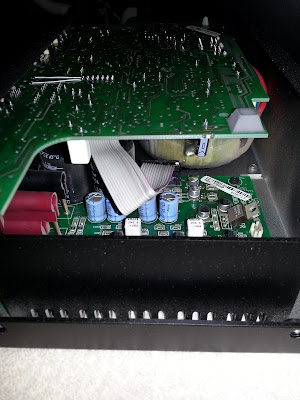It filled a few hours and, although it worked, it sounded pretty rubbish, as might be expectd. Within a week the taped seams had fallen apart and all the bits were back in their boxes. So that was that and here is the result, plus the early ideas about building something more substantial, that also came to absolutely nothing, except that the speaker drivers were still around in the garage: Sneeker Part 2
Although this post and the next 2 parts are being written in the early Summer in the UK, it actually relates back to a project that ran from time to time over the Winter of 2014/2015, I just haven't had time to write it all up. The actual result made a début in the bar at the 2015 Hifi Wigwam Show at Scalford Hall in Melton Mowbray - providing background music on Saturday evening.
So here are the first parts (the drivers) and thoughts about how to make something more substantial, more Linn and hopefully tolerable to listen to:
 |
| Drivers |
Standard RCA / Phono inputs so it could connect to pretty much any source
Mains powered - batteries are too restrictive
USB charging port to keep iPod or whatever going
Decent volume capability and therefore a proper power amp
Use the drivers already "in stock"
Room to add a Raspberry pi streamer later
Analogue volume control
A "robust" look
Low low cost
Here were the bits I had lying around in the garage that would suit:
4x Mission 100mm mid-bass drivers (see pic above)
Mission tweeters from 773e
Bits of wire
Mains cables
Mission 773e crossovers
T-Amp (which actually went elsewhere before work started, thankfully!)
Bits of wood and wood sheets
So much searching was done on ebay, and I discovered that Linn RoomAmps (from the Knekt multi-room system) sell for very small amounts of money. I also found that older Linn tweeters sell for a reasonable price too, and ALPs volume controls are cheap, if you can wait for them to arrive from China.
So, the following was assembled:
Linn RoomAmp (£27)
ALPs 10k stereo pot (£12)
USB charger (£3)
Mains switch and socket (£4)
Pair of Linn Index tweeters (£17)
USB socket (£5)
USB cable (£2)
Small black perspex sheet (£3)
z speaker plugs (£7)
Vivarium airvents (£3)
Originally I intended to build a box to put it all into, but my woodworking skills are a bit rubbish, to be honest, so more ebay searching for wood boxes found me something suitable - solid, the right kind of size, and very much fitting in with the "robust" theme. The box added another £15 to the parts cost.
Some experimenting on the bench with the drivers fitting into a cardboard shoebox indicated that the crossovers worked well with the drivers, and that the RoomAmp was healthy enough, so wood cutting and metal bending started.
 |
| Inside the Linn RoomAmp |
The amp has a bent metal sleeve that has overhangs along the long edges. I removed the sleeve, removed the fillets at the ends with a bit of sawing and power filing (power files - if you don't have one, get one, they're magical!), the overhangs were then bent at 90 degrees to the top panel, forming a lip that could be used for mounting the amp vertically inside the player. A bit of matt black spray paint was added to prevent rusting. After fitting the sleeve back onto the amp then a trial fit showed that it worked well inside the box.
Positioning the amp inside the box allowed measurement of where the dividers could be fitted to form the speaker cabinets, where the crossovers could be mounted, how to position the connections panel and where to cut holes for vents. Holes were then cut for the vents - one in the base to allow cool air in, one in the back to let warm air out, and the vivarium vents were glued in. The hole was then cut for the connections panel and the 18mm marine ply dividers were cut and fitted, after holes had been drilled to allow the 3 pairs of speaker cables into the speaker cabinet spaces. At this point all the internal joints were sealed with clear silicon sealant.
 |
| Lower cool air inlet vent, one of the divider panels (on the left) and 2 exmaples of how poor my woodworking skills are - good job this is all on the inside |
 |
| Sealing all the joints with clear silicon sealant |
 |
| Gluing the lower vent in place |


You Linn gear.😀 I was hoping for I little advise. I have two roomamps with the line level board removed. They work great. My question is:
ReplyDeleteCan I use one amp for one speaker?
If yes, which speaker connections should I use? I do not want to guess or experiment and frag something. Thank you for all of your informative posts and any help with my question. ATLjeffro
Thank you for your kind words.
DeleteIf you mean you only want to use one channel of each roomamp, it really doesn't matter. just use either of the red/black pairs. Only using one channel won't matter to the amp. If your speakers can be bi-amped, you could use one Roomamp to bi-amp each speaker - use a "jumper" cable between the inputs so that both channels receive the same information.
Enjoy.